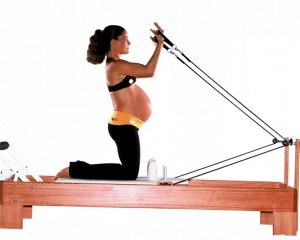Pregnant Women Should Avoid These 3 Pilates Moves
Pilates can be a safe and effective way to stay in shape while you are pregnant. If you are enjoying a healthy pregnancy, you may easily continue your regular workout well into your second trimester and possibly beyond. (A gynecologist friend I consulted said that if you an experienced pilates practitioner, can do most of their regular workout until about five or six months. Then you’ll need to make modifications for your comfort and safety.)

Though pilates can be very gentle, it’s best for everyone’s peace of mind if your doctor is on board. Please take your individual health profile into account in order to enjoy a safe and effective pre-natal pilates program. Pregnant women with special health conditions or high-risk pregnancies will have very specific limitations. Get details from your doctor to share with your instructor or arrange for your doctor and instructor to speak on the phone. New students who are pregnant should also get their doctor’s OK. Most pregnant women may continue their existing sports and physical activities if they were engaged in them prior to becoming pregnant. But doctors often caution against taking up new activities while pregnant. Make sure you know what is right for your situation.
Once you have the green light to continue your pilates program, enjoy it! As you near your third trimester, expect your instructor to start changing your program significantly to accommodate the changes in your body. In general, there are certain positions and movements that you’ll want to avoid:
1) Lying on your back too long
After your first trimester lying on your back for an extended period of time may lead to discomfort. Some doctors think this position effects blood flow of the mother and fetus and may cause blood pressure changes, dizziness and nausea. The degree of concern over this position seems to vary with each woman but I always choose to err on the safe side with my pregnant clients. Better to be a little conservative now and save the kick-a– workouts for after the baby comes.
2) Lying on your stomach
Obviously this position will become more uncomfortable as your baby bump grows. Instead, you can do prone exercises on your hands and knees so that you can still work on stability and back and hip extensions safely. You can also still do most of your side-lying exercises.
3) Deep stretching
Although it still feels good, deep stretches can be unsafe for pregnant women. Your hormones are loosening up your joints in preparation for delivery. It may be difficult for you to take a deep stretch without over-doing it. When I was in my certification program, we were told that the founder of our school was doing side splits on the reformer and her legs went side and side and side until they finally really split out on either side of her. Luckily she was an experienced dancer and pilates practitioner with extreme body control so she was able to pull herself together.
As your pregnancy progresses, keep your movements smaller and more controlled. You can come back to the big flowy stuff after the baby arrives and you start your post-pregnancy recover-my-body workout!
With a few modifications, you can continue the pilates program you love. I’ve had clients who started pilates with me before they were pregnant, went right through until they gave birth, took their six weeks to recover and picked right back up again. They reported feeling great through the process and were glad to feel relatively fit when they returned to for their post-natal program.
Don’t forget: mom’s health and happiness is just as important as the baby’s during this time. If you can keep up your pilates routine safely, you’ll feel stronger and happier throughout your pregnancy and have a head start in your post-pregnancy recovery. Let pilates help you build the strength and stamina you’ll need as a new mom!